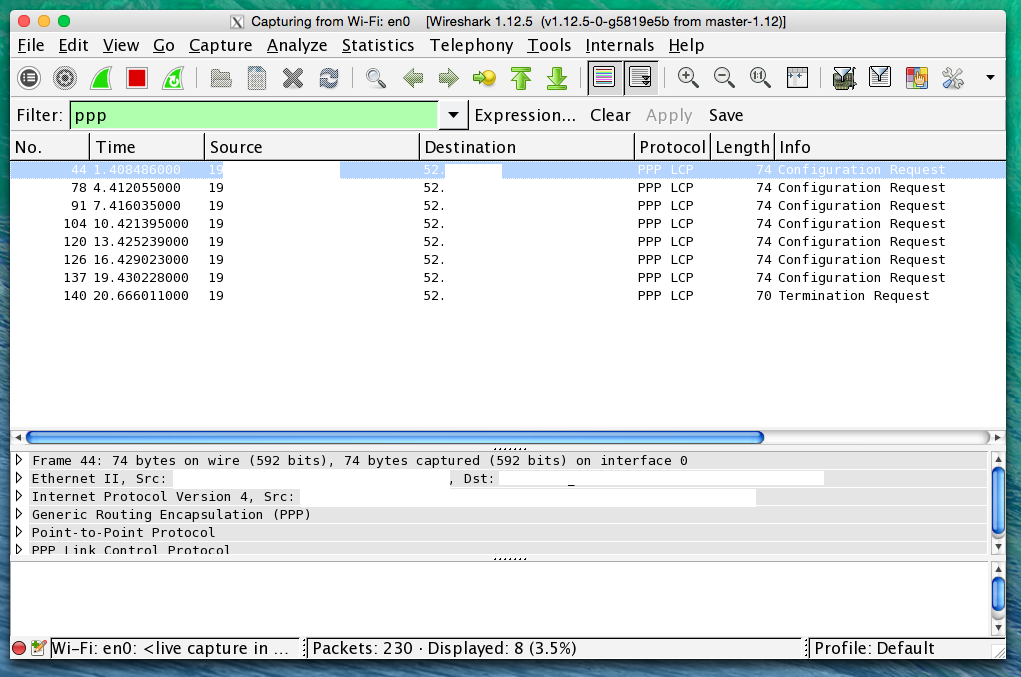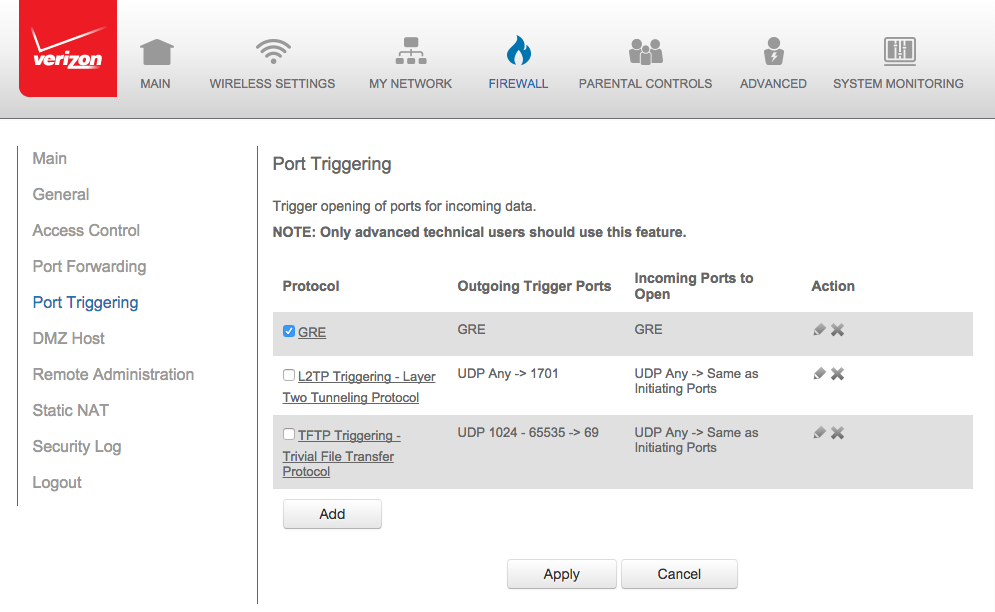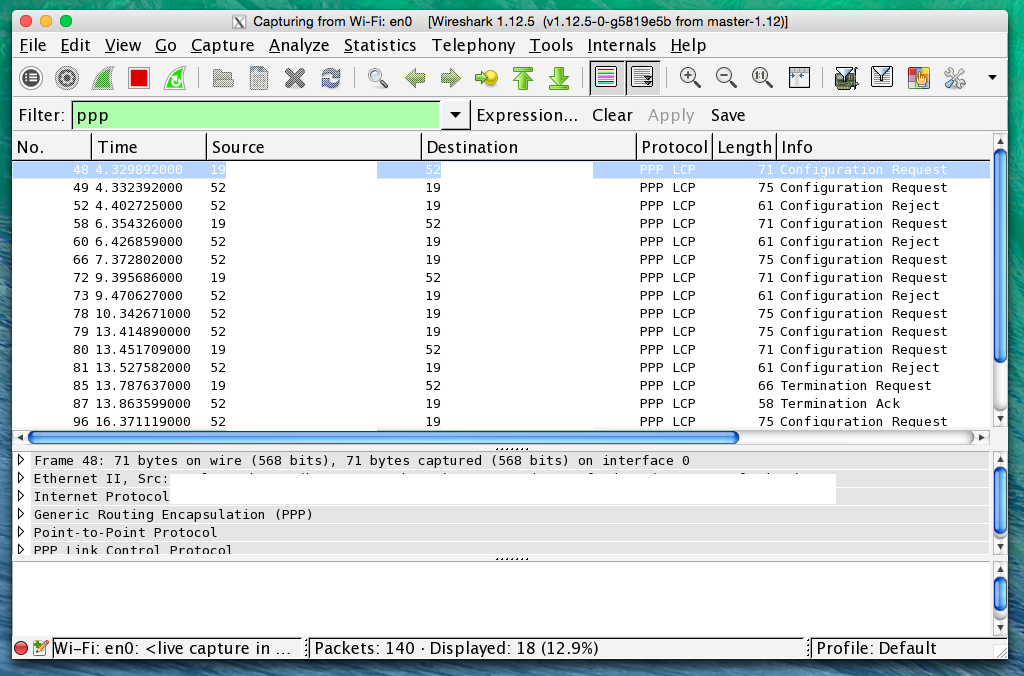Setting up PPTP and OpenVPN Service on Ubuntu Linux
Use VPN to avoid network censorship / logging and stay secure on open wifi networks.
Following is a configuration and troubleshooting process on an AWS EC2 instance.
I. Initial configuration
Install pptpd
apt-get install pptpd
Configure address pool
Add following to /etc/pptpd.conf:
localip 192.168.0.1
remoteip 192.168.0.2-10
Set DNS servers for clients
Add following to /etc/ppp/pptpd-options:
ms-dns 8.8.8.8
ms-dns 8.8.4.4
Add user accounts
Add following to /etc/ppp/chap-secrets:
user1 pptpd passwd1 *
user2 pptpd passwd2 *
Enable packet forwarding
Uncomment the following line in /etc/sysctl.conf:
net.ipv4.ip_forward=1
Reload settings
service pptpd restart
sysctl -p
Enable NAT
Add following lines above exit 0 in /etc/rc.local:
iptables -t nat -A POSTROUTING -s 192.168.0.0/24 -o eth0 -j MASQUERADE
iptables -A FORWARD -p tcp --syn -s 192.168.0.0/24 -j TCPMSS --set-mss 1200
Configure firewall rules
Permit inbound TCP 1723 and GRE(Protocol 47) traffic.
View VPN connection log (logwtmp must be enabled in /etc/pptpd.conf)
last | grep ppp
last -f /var/log/wtmp | grep ppp
last -f /var/log/wtmp.1 | grep ppp
...
II. Setting up OpenVPN Service
Reference: How To Set Up an OpenVPN Server on Ubuntu 14.04 - Digital Ocean
Install OpenVPN
apt-get install openvpn
Copy example configuration
gunzip -c /usr/share/doc/openvpn/examples/sample-config-files/server.conf.gz > /etc/openvpn/server.conf
In /etc/openvpn/server.conf, change:
dh dh1024.pem
to
dh dh2048.pem
Uncomment
;push "redirect-gateway def1 bypass-dhcp"
and
;push "dhcp-option DNS 8.8.8.8"
;push "dhcp-option DNS 8.8.4.4"
and
;user nobody
;group nogroup
and
# For multiple connections from clients using same certificate / key.
duplicate-cn
Configure Packet Forwarding
echo 1 > /proc/sys/net/ipv4/ip_forward
Add following lines above exit 0 in /etc/rc.local (If different subnet from PPTP service):
iptables -t nat -A POSTROUTING -s 192.168.0.0/24 -o eth0 -j MASQUERADE
iptables -A FORWARD -p tcp --syn -s 192.168.0.0/24 -j TCPMSS --set-mss 1200
Generate and copy CA & server certificates and key to /etc/openvpn/
Then, start and check the status of OpenVPN service:
service openvpn start
service openvpn status
View log in /var/log/syslog for troubleshooting.
III. Troubleshooting VPN Services
Problem 1
After setting up my VPN service, I found it was inaccessible from my home network, but accessible from mobile network.
I started pppd in debug mode (uncomment #debug in /etc/ppp/pptpd-options) plus Wireshark sniffing on client side, and I got result like this;
pppd[3273]: sent [LCP ConfReq id=0x1 <asyncmap 0x0> <auth chap MS-v2> <magic 0x64b52959> <pcomp> <accomp>]
pppd[3273]: rcvd [LCP ConfReq id=0x1 <asyncmap 0x0> <magic 0x378a50ac> <pcomp> <accomp>]
pppd[3273]: sent [LCP ConfAck id=0x1 <asyncmap 0x0> <magic 0x378a50ac> <pcomp> <accomp>]
pppd[3273]: sent [LCP ConfReq id=0x1 <asyncmap 0x0> <auth chap MS-v2> <magic 0x64b52959> <pcomp> <accomp>]
pppd[3273]: rcvd [LCP ConfReq id=0x1 <asyncmap 0x0> <magic 0x378a50ac> <pcomp> <accomp>]
pppd[3273]: sent [LCP ConfAck id=0x1 <asyncmap 0x0> <magic 0x378a50ac> <pcomp> <accomp>]

Apparently the server received ConfReq messages from the client and responded with ConfAck messages, but the client didn&’t receive them, the problem may be on the inbound firewall rules of client side.
Add an inbound rule on the client side router, the problem is solved.

Problem 2
Another problem is a Windows 7 running on my VM was not able to connect to VPN.
Using the same technique, I got the following:
sent [LCP ConfReq id=0x1 <asyncmap 0x0> <auth chap MS-v2> <magic 0x23cf9cf3> <pcomp> <accomp>]
rcvd [LCP ConfReq id=0x0 <mru 1400> <magic 0x63d1323> <pcomp> <accomp> <callback CBCP>]
sent [LCP ConfRej id=0x0 <callback CBCP>]
rcvd [LCP ConfReq id=0x1 <mru 1400> <magic 0x63d1323> <pcomp> <accomp> <callback CBCP>]
sent [LCP ConfRej id=0x1 <callback CBCP>]
sent [LCP ConfReq id=0x1 <asyncmap 0x0> <auth chap MS-v2> <magic 0x23cf9cf3> <pcomp> <accomp>]

It seems like the client requested with the Callback Control Protocol, which is not allowed on server side, hence the server replied with ConfRej messages.
After searching around the Internet for hours, I found a post said this is also a client-side firewall problem, after changing the VM networking mode from NAT to bridged network, the problem is solved.
Problem 3
On some network, connection will stop working after a heavy bandwidth utilization is occurred, your host will receive a large amount of Protocol Reject packets. This is mainly an ISP problem.